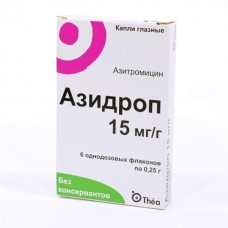Expiration date: 12/2026
DOSAGE FORMS
eye drops of 15 mg / g
MANUFACTURERS
Laboratuar Uniter (France)
GROUP
Antibiotics - macrolides and azalides
COMPOSITION
The active ingredient - azithromycin dihydrate, 15 mg (in terms of azithromycin 14,3mg) Excipients: medium-chain triglycerides to 1d.
International Nonproprietary Names
Azithromycin
SYNONYMS
Azivok, Azimitsin, Azitral, Azitroks, Azithromycin, Azithromycin Zentiva, Azithromycin Forte, Azithromycin-OBL, Azithromycin-Akos, AzitRus, AzitRus fort Azitsid, Vero Azithromycin, Zetamaks retard, Z-Factor, Zitrolid, Zitrolid fort Zitrotsin, Sumazid , Sumamed, Sumamed forte, Sumametsin, Sumamoks, Sumatrolid Solyushn Tablets, Hemomitsin, Ecomed
PHARMACHOLOGIC EFFECT
Azithromycin is a broad spectrum antibacterial actions belonging to the class of azalides, inhibits protein synthesis by binding to the 50S-ribosomal subunit, inhibits the growth and reproduction of bacteria, in high concentrations has a bactericidal effect. It works on the extra- and intracellular pathogens. It is active against Gram-positive microorganisms: Streptococcus spp. (Groups C, F and G, except resistant to erythromycin), Streptococcus pneumoniae, Streptococcus pyogenes, Streptococcus agalastiae, Streptococcus viridans group, Staphylococcus epidermidis, Staphylococcus aureus, gram-negative bacteria: Haemophilus influenzae, Moraxella catarrhalis, Bordetella pertussis, Bordetella parapertussis, Legionella pneumophila , Haemophilus ducreyi, Campylobacter jejuni, Neisseria gonorrhoeae and Gardnerella vaginalis, some anaerobic bacteria: Prevotella bivia, Clostridium perfringens, Peptostreptococcus spp, and Chlamydia trachomatis, Chlamydia pneumoniae, Mycoplasma pneumoniae, Mycobacterium avium somrleh, Ureaplasma urealyticum, Treponema pallidum, Borrelia burgdorferi. Activity against Gram-positive bacteria resistant to erythromycin. Provided pharmacokinetics of the drug twice a day provided adequate therapeutic concentration of azithromycin in the tear fluid. The half-life of the tear fluid is about 12 hours. The concentration of azithromycin in plasma after instillation of eye drops at the recommended dose Azidrop - less than the detection limit (below 0.0002 g / ml).
TESTIMONY
Treatment of conjunctivitis caused by susceptible to malaria pathogens, including Chlamydia trachomatis, in adults and children from 1 year.
CONTRAINDICATIONS
Individual hypersensitivity to azithromycin and other macrolide antibiotics, as well as the components of an age less than 1 year. Pregnancy and lactation Poskolky systemic exposure to azithromycin is negligible, the harmful effects of the drug during pregnancy is not expected. Perhaps the use of the drug Azidrop, eye drops for the treatment of pregnant women for the purpose of the attending physician, if the expected therapeutic benefit to the mother outweighs the risk of possible side effects in the fetus. There is limited evidence that azithromycin is excreted in breast milk, but, considering the low dose and the low systemic availability, effects on the newborn is negligible. Thus, treatment with the drug Azidrop breastfeeding permissible. Babies under one year do not have enough experience trachomatous treatment of conjunctivitis and purulent bacterial conjunctivitis with eye drops Azidrop in children under the age of one year.
SIDE EFFECT
Side effects noted during the studies Azidrop drug, eye drops, systematized according to the World Health Organization classification (WHO) on the frequency of occurrence: Violations of the immune system. Very rare: hypersensitivity, angioneurotic edema (angioedema). Violations by the eyes. Very common: ocular discomfort (itching, burning, tingling) after instillation of the drug. Common: blurred vision, feeling of "sticking" eyelids, foreign body in the eye. Uncommon: lacrimation. Very rare: eczema, erythema, swelling of the eyelids, eye allergy, conjunctival hyperemia, allergic conjunctivitis, conjunctivitis, keratitis.
INTERACTION
Drug interaction studies have not been conducted Azidrop all specific drugs. In the absence of azithromycin concentrations determined in plasma during instillation of eye drops, is not expected to interact with either of the drugs that interact with azithromycin when administered orally.
Dosage and Administration
Locally. Adults and adolescents (12 to 17 years), children (2 to 11 years): instill one drop into the conjunctival sac of the affected eye twice a day (morning and evening) for three days. If there is no positive dynamics within 3 days of the drug, you should consult with your doctor and review the treatment. Children (from 1 year to 2 years old) in the treatment of conjunctivitis trachomatous dose adjustment is required. There is little experience of treatment of purulent bacterial conjunctivitis with eye drops Azidrop in children younger than 2 years. In elderly patients older dose adjustment is required. Patients should follow the following guidelines: - it is necessary to wash hands thoroughly before and after instillation of the drops procedure - do not touch the eyes and the tip of the dropper bottle century - after a single use tube-dropper must be discarded along with the available balances. You can not use the remaining solution in the tube-dropper for the next instillation.
OVERDOSE
Details of the cases there is no overdose. The packaging for single use azithromycin present in an amount sufficient to treat both eyes, but insufficient to cause adverse reactions after accidental intravenous administration or oral solution.
SPECIAL INSTRUCTIONS
Eye drops should not be administered by injection or swallowed. Eye drops can not be administered in the peri- and intraocular injection. In the case of an allergic reaction to the drug treatment should be discontinued. In the case of concomitant treatment of other ophthalmic drugs, drug Azidrop Bury least, 15 minutes after instillation of the other drug. According to the existing international guidelines on the treatment of eye diseases and urinary tract, which can be highly likely to be transmitted to newborns, conjunctivitis netrahomatoznogo origin, called by Chlamydia trachomatis, and conjunctivitis caused by Neisseria gonogrhoeae require systemic treatment. Except for the treatment of trachomatous conjunctivitis, eye drops Azidrop not recommended for use in children younger than two years, as there is no sufficient clinical information to conduct therapy in this age group. This type of treatment is not intended for use as prevention of bacterial conjunctivitis in the newborn. The patient should be informed that there is no need to continue eye drops after completion of therapy on the third day, even if residual signs of bacterial conjunctivitis are still present. Patients suffering from bacterial conjunctivitis should not wear contact lenses. Against the background of systemic use of azithromycin reported cases of fulminant hepatitis, which can potentially lead to life-threatening liver failure. When using the drug in ophthalmology such a risk does not exist, since the systemic exposure of the active ingredient is extremely small. Patients who after applying eye drops observed transient blurred vision, is not recommended to drive vehicles or operate machinery until the restoration of vision.
STORAGE CONDITIONS
Keep out of the reach of children, at a temperature not exceeding 25C.


